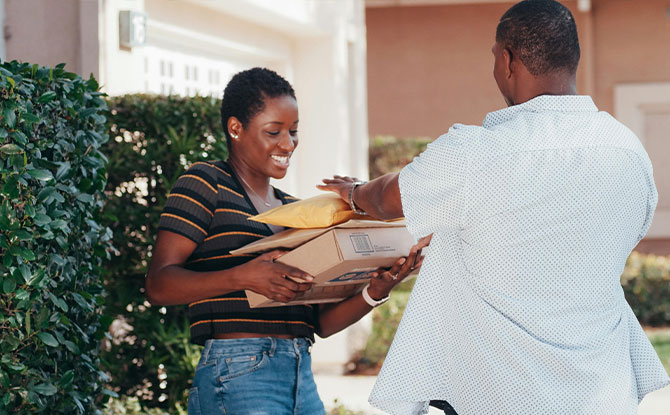It’s now easier than ever for people to shop with online shopping. But, it also brings environmental problems like too much packaging and single-use plastics. By choosing sustainable online shopping, we can help the planet. This guide will show you how to do some eco friendly online shopping.
We’ll talk about making smart choices, like buying only what you need and choosing stores that care about the planet. We’ll also cover how to pick products with less packaging and how to combine orders. Our goal is to help you live a greener life even when online shopping.
Understanding the Environmental Impact of Online Shopping

Online shopping has grown fast, but it’s bad for the environment. The packaging needed to ship products adds to e-commerce waste. Items often come in big boxes with single-use plastics, which end up in landfills.
The carbon footprint of online shopping isn’t just about packaging. The delivery process, which includes trucks and planes, also releases greenhouse gases. This adds to the environmental cost of buying things online.
It’s important for shoppers to know how their choices affect the planet. By understanding the environmental impact, people can make better choices. For example, they might order fewer items to cut down on emissions or choose stores that use eco-friendly packaging.
Knowing about the carbon footprint of online shopping helps us make a difference. We can all play a part in reducing our ecological footprint and working towards a greener future.
Mental Check-In: Assessing the Necessity of Your Purchase
Reflecting on whether you really need something before buying is key to less waste from online shopping. Darby Hoover from the Natural Resources Defense Council says stopping to think can stop unnecessary buys. Looking for alternatives like borrowing or buying second-hand can cut down on waste and harm to the environment.
Mindful shopping leads to more thoughtful buying. It helps us make choices that are better for the planet and avoid buying on impulse. Taking a moment to think about each purchase can lead to more mindful spending, helping both us and the environment.
Avoiding Greenwashing: How to Spot Genuine Eco-Friendly Claims
Greenwashing is a big problem for those who want to buy eco-friendly products. Companies might use fake marketing to make their products seem green. David Pinsky, who used to work at Greenpeace, says we need to check these claims by looking at a company’s real actions and promises.
To find true eco-claims, we should look for real actions by companies. For example, if a brand says it uses recycled materials, they should show proof. Also, look for certifications from groups like the Forest Stewardship Council (FSC) or the Global Organic Textile Standard (GOTS).
Stopping fake green claims starts with knowing the facts. We can tell if a company is really trying to be eco-friendly by looking at their history and actions. It’s important to choose brands that are open and honest about their green efforts. This helps create a market that values real green actions over fake ones.
Choosing Eco-Friendly Retailers for Sustainable Shopping
Supporting sustainable e-tailers is key in moving towards a greener future. Choosing retailers that focus on ethical shopping can greatly impact the environment and the industry. Businesses that use renewable energy and follow fair trade principles lead the way.
Look for certifications like Fair Trade, USDA Organic, or B Corp. These show a brand’s commitment to being eco-friendly. They ensure the brand treats workers fairly and produces sustainably. When we choose to shop ethically, we push for more sustainable options.
By picking eco-friendly retailers, we help create a better world. These practices not only cut down our carbon footprint but also encourage others to shop sustainably. Every time we buy, we’re choosing a healthier planet.
Supporting Local Businesses to Reduce Carbon Footprint

Shopping online from local businesses cuts down on carbon emissions. This is because products travel shorter distances. This leads to a smaller carbon footprint.
Many local sellers use less packaging, which also reduces waste. This is good for the environment.
Choosing local sellers helps the environment and the local economy. The money stays in the community, helping it grow. You can find local sellers on Facebook Marketplace and neighborhood apps.
Switching to local e-commerce has big benefits for the planet and the economy. It’s a smart choice for those who care about the environment.
Eco-Friendly Online Shopping: Strategies for Minimizing Waste
In today’s digital world, it’s key to reduce waste when shopping online. One good way is to combine orders to cut down on shipping and packaging. Choosing products that are better for the planet can also help a lot.
Buying second-hand or refurbished items is another smart move. It helps reduce waste and makes products last longer. Also, picking stores that use green packaging is a big plus.
As a conscious shopper, you can push for change. Recycling packaging and asking for eco-friendly choices can help. Every small action we take can lead to big changes in online shopping.
Utilizing Second-Hand and Refurbished Products
Buying refurbished goods online can make products last longer and reduce environmental harm.
Choosing refurbished products helps cut down on waste and saves resources. It supports a greener lifestyle and lowers the need for new items. These sites offer savings and unique, quality items, too.
For a better shopping experience, set up alerts for items you want. This way, you can quickly buy refurbished goods when they’re available. Using second-hand options helps reduce waste and promotes eco-friendly shopping.
Reducing Packaging Waste: Tips and Tricks

Reducing packaging waste is key to sustainable living. By choosing how our purchases are packaged and shipped, we can make a big difference. One smart move is to ask for consolidated shipping. This way, we can use less packaging, helping the environment.
Choosing reusable or recyclable materials is also important. Companies like FedEx, UPS, and Amazon let us return used packaging for reuse or recycling. This cuts down on waste and supports sustainable packaging. Always check if retailers offer these eco-friendly options.
For even more impact, try curbside pickup. It means less packaging and lower emissions. Also, look for retailers that focus on sustainable packaging. And don’t forget to recycle packaging materials properly. These actions can greatly reduce packaging waste.
Get more eco-friendly tips by reading this article: Solid Bar Soaps vs Liquid Soaps: Which Is Best?

